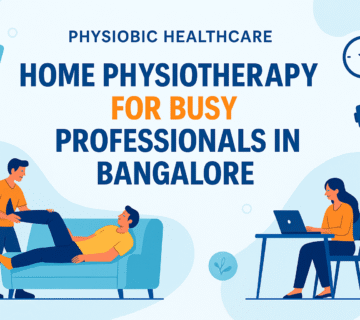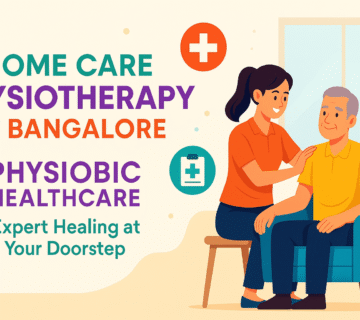Abstract
Knee Osteoarthritis Physiotherapy at Home in Bangalore is a common joint disease that affects millions worldwide. It causes pain, reduced movement, and a lower quality of life. In Bangalore, where urban living and sedentary lifestyles are increasing, home-based physiotherapy for knee OA is crucial. This article discusses the nature of knee osteoarthritis, the role of physiotherapy, its benefits, treatment options, and practical strategies for implementing home physiotherapy effectively.
Introduction to Knee Osteoarthritis Physiotherapy at Home in Bangalore
Knee osteoarthritis is primarily caused by the wear and tear of cartilage in the knee joint. This condition leads to pain, stiffness, swelling, and reduced function. As Bangalore grows and lifestyles change, more people are experiencing knee OA. Effective and accessible treatment options are essential.
Physiotherapy is a key part of managing knee osteoarthritis. Home-based physiotherapy allows for personalized care in a comfortable environment. This can improve patient adherence and outcomes.
Understanding Knee Osteoarthritis Physiotherapy at Home in Bangalore
Knee osteoarthritis develops from various factors, including:
- Age: The risk increases as people get older.
- Obesity: Extra weight adds stress to the knees.
- Previous Injuries: Past injuries can lead to OA later.
- Genetics: A family history of OA can increase risk.
- Repetitive Stress: Jobs that involve repetitive knee movements can cause wear.
Symptoms of Knee Osteoarthritis
Symptoms can vary but often include:
- Joint Pain: Pain during or after activity.
- Stiffness: Often felt in the morning or after sitting for a while.
- Swelling: Caused by inflammation in the joint.
- Limited Movement: Difficulty bending or straightening the knee.
- Creaking Sounds: A grinding or crunching sensation during movement.
Recognizing these symptoms early can help in getting timely treatment.
The Role of Physiotherapy in Knee Osteoarthritis
Physiotherapy is essential for managing knee osteoarthritis. It provides a holistic approach and focuses on individual patient needs. Home physiotherapy in Bangalore offers comfort and flexibility, which can enhance treatment effectiveness.
Key Objectives of Physiotherapy
- Pain Relief: Various techniques help reduce pain and inflammation.
- Restoration of Function: Tailored exercises can improve movement and functionality.
- Education: Teaching patients about their condition helps them manage it better.
- Preventing Disease Progression: A structured physiotherapy plan can slow down the progression of OA.
Benefits of Knee Osteoarthritis Physiotherapy at Home in Bangalore
- Pain Management: Techniques like manual therapy and modalities can effectively reduce pain.
- Strength Improvement: Focused exercises strengthen the muscles around the knee.
- Increased Flexibility: Stretching routines improve flexibility and range of motion.
- Weight Management: A good exercise program can help with weight loss.
- Enhanced Quality of Life: Better mobility and less pain lead to greater independence.
Knee Osteoarthritis Physiotherapy at Home in Bangalore Options
1. Exercise Therapy
Strengthening Exercises: These target muscles around the knee. Examples include:
- Straight Leg Raises: Strengthens the quadriceps.
- Wall Sits: Engages multiple muscles while supporting the knee.
- Calf Raises: Strengthens the calves.
Flexibility Exercises: Stretching helps maintain and improve movement. Effective stretches include:
- Hamstring Stretch: Alleviates tightness in the back of the leg.
- Quadriceps Stretch: Promotes flexibility in the front thigh.
- Calf Stretch: Improves flexibility in the lower leg.
Low-Impact Aerobic Exercises: Activities that enhance fitness without stressing the knees are important. Options include:
- Cycling: Improves strength and endurance.
- Swimming: Provides a full-body workout with minimal joint stress.
- Walking: Regular walking can promote joint health.
2. Manual Therapy
Manual therapy involves hands-on techniques to relieve pain and improve movement. Physiotherapists may use joint mobilization and soft tissue massage to address specific issues.
3. Modalities
Heat Therapy: Applying heat through warm compresses can relax muscles and improve blood flow.
Cold Therapy: Ice packs reduce swelling and numb pain after activity.
Electrical Stimulation: TENS (Transcutaneous Electrical Nerve Stimulation) units can provide effective pain relief.
4. Education and Self-Management
Education is a key part of physiotherapy. Patients learn about their condition and self-management techniques. Important topics include:
- Proper Body Mechanics: Learning to move in ways that minimize strain.
- Activity Modification: Adapting exercises and daily tasks.
- Weight Management Strategies: Nutrition and exercise tips for weight loss.
5. Assistive Devices
Physiotherapists may recommend devices like:
- Braces: To support the knee during activities.
- Orthotics: Customized shoe inserts to improve alignment.
- Mobility Aids: Canes or walkers for stability.
Implementing Knee Osteoarthritis Physiotherapy at Home in Bangalore
In Bangalore, many physiotherapy clinics and professionals offer home-based services tailored for knee osteoarthritis. This model allows patients to receive personalized care in their homes, enhancing comfort and adherence to treatment.
Steps for Effective Implementation
- Initial Consultation: Patients should start with an assessment by a qualified physiotherapist to create a personalized treatment plan.
- Regular Sessions: Consistency is important. Scheduling regular physiotherapy sessions can help track progress.
- Exercise Routines: Patients should do prescribed exercises regularly, following their physiotherapist’s guidance.
- Monitoring Progress: Regular follow-ups can help adjust the treatment plan based on progress.
- Family Involvement: Encouraging family members to participate can enhance motivation.
Challenges and Considerations
While home physiotherapy has many benefits, challenges can arise:
- Patient Motivation: Some may struggle with self-discipline. Setting realistic goals and maintaining communication with the physiotherapist can help.
- Space and Equipment: Patients may need enough space and basic equipment for effective workouts.
- Access to Professionals: Availability of qualified physiotherapists may vary, so it’s important to seek reputable clinics.
Conclusion
Knee osteoarthritis is a major health concern affecting many individuals in Bangalore. Home-based physiotherapy offers an effective management strategy. It combines pain relief, improved mobility, and education to empower patients. By following a personalized exercise regimen and incorporating self-management strategies, those with knee osteoarthritis can enhance their well-being and regain independence.
References
- American Academy of Orthopaedic Surgeons. (2021). Knee Osteoarthritis.
- Hwang, C. H., & Choi, T. Y. (2019). Effects of Physiotherapy on Knee Osteoarthritis. Journal of Rehabilitation Medicine.
- Zhang, W., et al. (2010). Osteoarthritis Research Society International Recommendations for the Management of Hip and Knee Osteoarthritis. Osteoarthritis and Cartilage.
- Deyle, D. R., et al. (2000). Physical Therapy for the Treatment of Osteoarthritis of the Knee. New England Journal of Medicine.
- Hunter, D. J., & Bierma-Zeinstra, S. (2019). Osteoarthritis. The Lancet.



